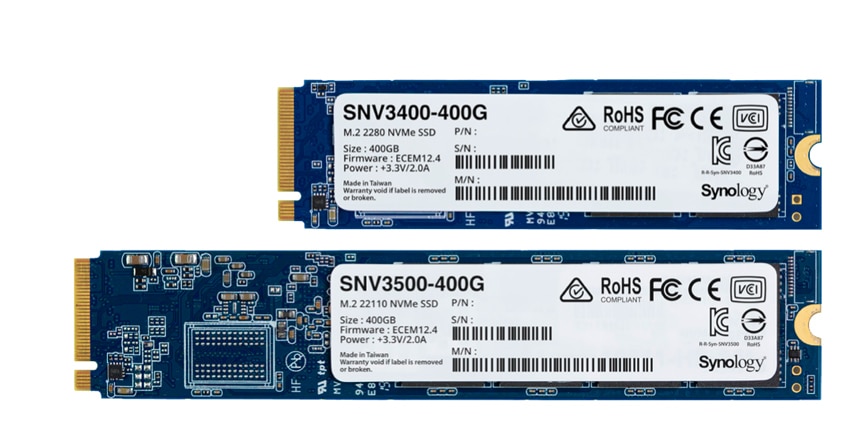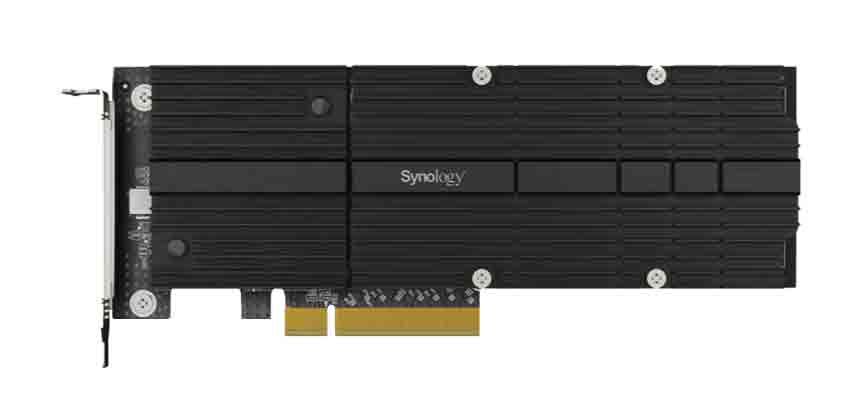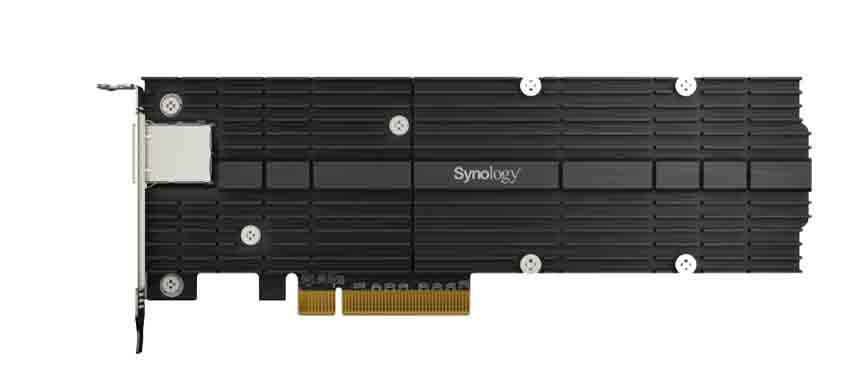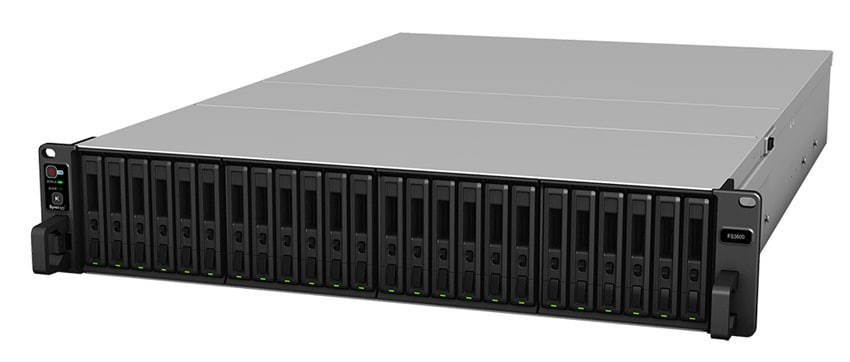In a somewhat unusual move, Synology Inc. launched its own series of SSDs. These new Synology SSD line comes in 2.5” SATA, M.2 2280, and M.2 221100 form factors and are said to provide high performance with low latency. The SSDs are geared toward virtualization workloads, high traffic volume database storage, and AI and HPC projects and most likely the company’s own NAS line. On that note, Synology is also releasing a new all-flash NAS in the Synology FlashStation 3600.
In a somewhat unusual move, Synology Inc. launched its own series of SSDs. These new Synology SSD line comes in 2.5” SATA, M.2 2280, and M.2 221100 form factors and are said to provide high performance with low latency. The SSDs are geared toward virtualization workloads, high traffic volume database storage, and AI and HPC projects and most likely the company’s own NAS line. On that note, Synology is also releasing a new all-flash NAS in the Synology FlashStation 3600.
Synology has been around for some time now and is mostly known for their NAS devices. They make everything from 1-bay desktop mounts up to 24-bay rackmount units and span the use cases from the casual home user to the small enterprise. Another thing they are known for is the Synology DiskStation Manager (DSM) OS that is used on all version of their NAS devices. DSM is extremely user friendly and one of the most intuitive NAS OSs out there that beginners can start using right away. While the company does make a few other things, including routers, it is mainly known for NAS, until today with the Synology SSD Line.
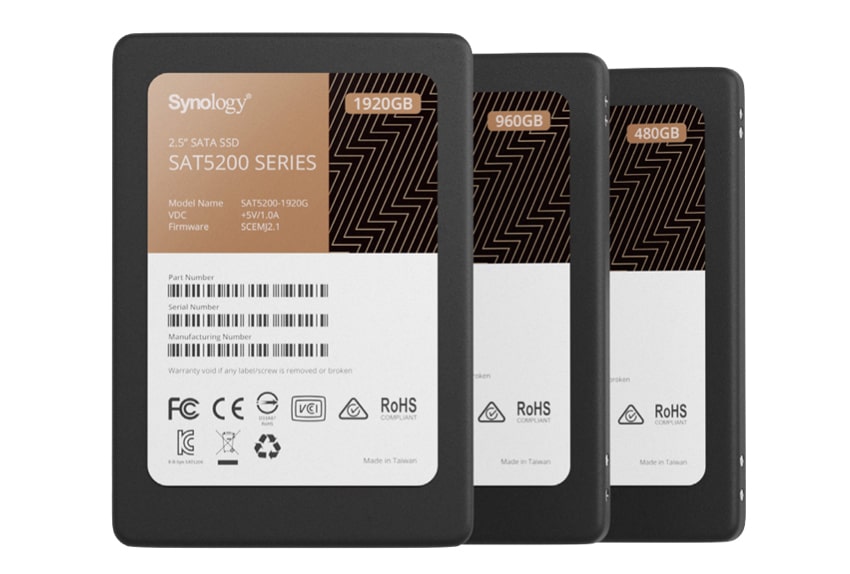
The move to make SSDs starts with the SAT5200, a SATA 2.5” drive. The drive is said to deliver up to 98K IOPS read and 67K IOPS write in 4K random with minimal performance degradation across the drive’s lifespan. The SAT5200 also comes with power-loss protection and end-to-end data path protection for enhanced data durability, minimizing service disruptions due to data corruption. The drive comes in 480GB to 1.92TB capacities.
Synology SAT5200 Specifications
| Model number | SAT5200-480G | SAT5200-960G | SAT5200-1920G |
| Capacity | 480GB | 960GB | 1.92TB |
| Form factor | 2.5″ 7mm | ||
| Interface | SATA 6 Gb/s | ||
| Performance | |||
| Sequential read (128 KB, QD32) | 530 MB/s | ||
| Sequential write (128 KB, QD32) | 500MB/s | ||
| Random read (4 KB, QD32) | 95,000 IOPS | 98,000 IOPS | |
| Random write (4 KB, QD32) | 55,000 IOPS | 67,000 IOPS | 60,000 IOPS |
| Endurance and Reliability | |||
| Terabytes Written (TBW) | 1,145TB | 2,290TB | 4,581TB |
| Drive Writes Per Day (DWPD) | 1.3 | ||
| Mean Time Between Failures (MTBF) | 1.5 million hours | ||
| Uncorrectable Bit Error Rates (UBER) | < 1 sector per 10^17 bits read | ||
| Power loss protection | Yes | ||
| Warranty | 5 years | ||
| Power Consumption | |||
| Supply voltage | 5 V (± 10%) | ||
| Active read (Typ.) | 2.6W | 2.9W | 3.1W |
| Active write (Typ.) | 4.2W | 4.6W | 5.1W |
| Idle | 1.4W | 1.5W | 1.6W |
| Temperature | |||
| Operation temperature | 0°C to 70°C (32°F to 158°F) | ||
| Storage temperature | -40°C to 85°C (-40°F to 185°F) | ||
| Others | |||
| Dimension (H x W x D) | 7.0 mm x 69.85 mm x 100 mm | ||
| Certification | CE, FCC, VCCI, RCM, BSMI, KC, RoHS | ||
For NVMe and M.2, the company is offering the Synology SNV3400 and SNV3500 NVMe series. This series is ideal for usage in Synology NAS that have the M.2 bays on the bottom for caching. Through the caching, users can accelerate HDDs in their NAS while not giving up capacity. Both drives come in a capacity of 400GB and are quoted to hit upwards of 3.1GB/s read, 550MB/s write, with throughputs of 205K IOPS read and 40K IOPS write.
Synology SNV3400 and SNV3500 Specifications
| Model number | SNV3400-400G | SNV3500-400G | |
| Capacity | 400GB | ||
| Form factor | M.2 2280 | M.2 22110 | |
| Interface | NVMe PCIe 3.0 x4 | ||
| Performance | |||
| Sequential read (128 KB, QD32) | 3,100MB/s | ||
| Sequential write (128 KB, QD32) | 550MB/s | ||
| Random read (4 KB, QD32) | 205,000 IOPS | ||
| Random write (4 KB, QD32) | 40,000 IOPS | ||
| Endurance and Reliability | |||
| Terabytes Written (TBW) | 500TB | ||
| Drive Writes Per Day (DWPD) | 0.68 | ||
| Mean Time Between Failures (MTBF) | 1.8 million hours | ||
| Uncorrectable Bit Error Rates (UBER) | < 1 sector per 10^17 bits read | ||
| Power loss protection | Yes | ||
| Warranty | 5 years | ||
| Power Consumption | |||
| Supply voltage | 3.3 V (± 10%) | ||
| Active read (Typ.) | 3.2W | 3.7W | |
| Active write (Typ.) | 3.2W | 3.4W | |
| Idle | 2.0W | ||
| Temperature | |||
| Operation temperature | 0°C to 70°C (32°F to 158°F) | ||
| Storage temperature | -40°C to 85°C (-40°F to 185°F) | ||
| Others | |||
| Dimension (H x W x D) | 3.5 mm x 22 mm x 180 mm | 4.5 mm x 22 mm x110 mm | |
| Certification | CE, FCC, VCCI, RCM, BSMI, KC, RoHS | ||
If you have a Synology device without an M.2 slot, what do you do? The company has you covered. Synology has released two adaptors, the Synology M2D20 and E10M20-T1. These two adaptors let users take advantage of all the benefits of the above M.2 drives. The M2D20 allows for additional storage through the SNV3400 and SNV3500 NVMe series with two slots for either. The E10M20-T1 does the same as the above and adds 10GbE connectivity to further boost performance.
M2D20 Specifications
| Host Bus Interface | PCIe 3.0 x8 |
| Bracket Height | Low-profile and full-height |
| Size (Height x Width x Depth) | 71.75 mm x 181.9 mm x 15.8 mm |
| Operating Temperature | 0°C to 40°C (32°F to 104°F) |
| Storage Temperature | -20°C to 60°C (-5°F to 140°F) |
| Relative Humidity | 5% to 95% RH |
| Warranty | 5 years |
| Storage | |
| Storage Interface | NVMe |
| Supported Form Factor | M.2 22110/2280 |
| Connector Type and Quantity | M-key, 2 slots |
E10M20-T1 Specifications
| Host Bus Interface | PCIe 3.0 x8 |
| Bracket Height | Low-profile and full-height |
| Size (Height x Width x Depth) | 71.75 mm x 200.55 mm x 17.7 mm |
| Operating Temperature | 0°C to 40°C (32°F to 104°F) |
| Storage Temperature | -20°C to 60°C (-5°F to 140°F) |
| Relative Humidity | 5% to 95% RH |
| Warranty | 5 years |
| Storage | |
| Storage Interface | NVMe |
| Supported Form Factor | M.2 22110/2280 |
| Connector Type and Quantity | M-key, 2 slots |
| Network | |
| IEEE Specification Compliance | • IEEE 802.3an 10GBASE-T 10Gbps Ethernet • IEEE 802.3bz NBASE-T 5/2.5Gbps Ethernet • IEEE 802.3ab 1000BASE-T Gigabit Ethernet • IEEE 802.3u 100BASE-Tx Fast Ethernet • IEEE 802.3x Flow Control |
| Connector | RJ45 Copper |
| Data Transfer Rates | 10/5/2.5/1Gbps and 100Mbps |
| Network Operation Mode | Full Duplex |
| Supported Features | • 9 KB Jumbo Frame • TCP/UDP/IP Checksum Offloading • Auto-negotiation between 100Mb/s, 1Gb/s, 2.5Gb/s, 5Gb/s, and 10Gb/s |
Once again, the company is releasing a FlashStation, or an all-flash NAS. The Synology FlashStation 3600 is, to no surprise, aimed at performance with an Intel Xeon 12-core CPU (D-1567), up to 128GB of DDR4 RAM, up to 56GbE connectivity, and the ability to scale up to 72 flash drives. The FlashStation 3600 is quoted to be able to hit over 195K IOPS random write. The NAS is aimed at database, virtualization, or OLTP applications.
Synology FlashStation 3600 Specifications
| CPU | Intel Xeon D-1567 12-core 2.1GHz, Turbo Boost up to 2.7GHz |
| Hardware encryption engine | Yes (AES-NI) |
| Memory | 16GB DDR4 ECC RDIMM (expandable up to 128 GB) |
| Compatible drive type | 24 x 2.5″ SAS SSD/HDD or SATA SSD (drives not included) |
| Hot swappable drive | Yes |
| External port | • 2 x USB 3.0• 1 x Expansion |
| Size (HxWxD) | • 88 x 430.5 x 692 mm • 88 x 482 x 724 mm (with server ears) |
| Weight | 14.9 kg |
| LAN port | • 4 x 1GbE RJ-45 • 2 x 10GbE RJ-45 |
| Wake on LAN/WAN | Yes |
| PCIe 3.0 slot | • 1 x 8-lane x8 slot • High-performance network interface card support |
| Scheduled power on/off | Yes |
| System fan | 4 (80 x 80 x 32 mm) |
| AC input power voltage | 100 V to 240 V AC |
| Power frequency | 50/60Hz, single phase |
| Operating temperature | 0°C to 35°C (32°F to 95°F) |
| Storage temperature | -20°C to 60°C (-5°F to 140°F) |
| Relative humidity | 5% to 95% RH |
| Maximum operating altitude | 5,000 m (16,400 ft) |
Availability
The Synology SSD Line and Synology FlashStation 3600 are available now.
Engage with StorageReview
Newsletter | YouTube | Podcast iTunes/Spotify | Instagram | Twitter | Facebook | RSS Feed

